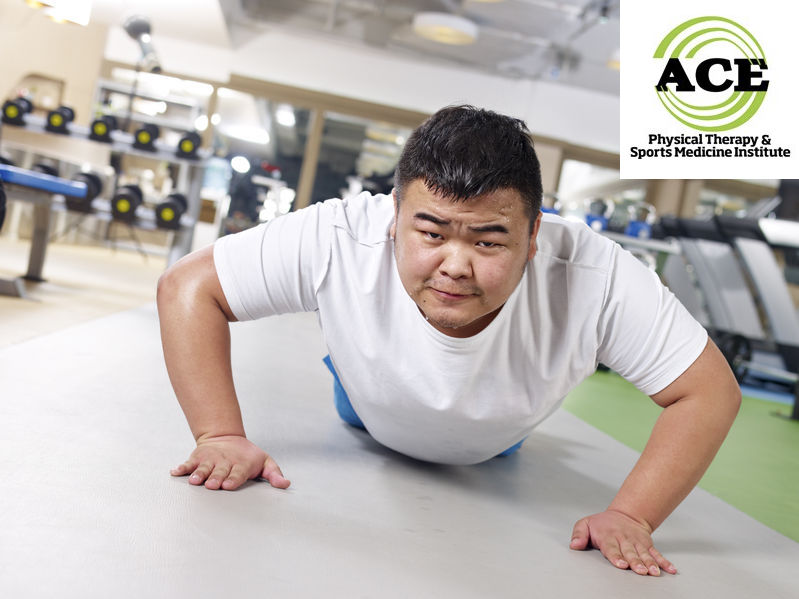OBESITY AND JOINT PAIN

Tid Bits of Info
- 1 in 5 people are diagnosed with OA but 1 in 3 obese people develop OA.
- More than 27 million people are diagnosed with OA every year.
- Every pound of excess weight exerts approximately 4 pounds of extra pressure on the knee joints.
- To lose 1 pound of body weight, you have to “burn” approximately 3500 calories.
- If you develop painful joints, seek the advice and treatment from a Physical Therapist.
According to The State of Obesity: Better Policies for a Healthier America released in September 2016, Washington, D.C. now has the second lowest adult obesity rate in the nation. Click here to to know the obesity rate of your state.
Does gaining weight and being “over-weight” cause more joint pain in the body? Osteoarthritis is one area where we see an increase in joint pain due to weight gain. The frequency of Osteoarthritis (OA) in the obese population is 1 out of 3 people, but some obese people struggle to see this think. Why? Because they have carried excess body weight for a long time and only now are beginning to experience pain. Healthcare professionals work with obese patients to help them lost weight and life a healthier lifestyle.
The fat or adipose tissue is being studied a great deal because it is thought to release chemicals (cytokines specifically adipokines) that can lead to an increase in inflammation throughout the body and joints. The inflammatory response has been linked to the development of OA throughout the body. These chemicals and the inflammatory response can cause pain and increase the difficulty of treating many conditions such as Rheumatoid arthritis.
Joints and Joint Pain
The joints of the body are the union of 2 or more bones that move or articulate together. The ends of the bones are covered with a smooth, articular cartilage (hyaline cartilage) that can “wear out” and get damaged over the course of one’s lifetime. If the damage or arthritic change is great enough, the joint will hurt and in the worst case scenario might have to be replaced by an orthopaedic surgeon.
Obesity and Joint Pain
The joints of the body are subjected to shear and compressive forces with every movement. These forces are handled by static and dynamic stabilizing structures around the joint, but the increased force placed on the joints of an obese person can be too great to handle. The frequency of Osteoarthritis (OA) in the obese population is 1 out of 3 people! The joints that are most frequently affected are the weight bearing joints such as the hips and knees.
Once patients begin to suffer from OA and other forms of joint pain, they are less active. This inactivity leads to more weight gain, and this cycle is not good for their joints or general health.
Losing Weight and Getting Better
Losing weight and maintaining a regular exercise routine will help to increase the quality of one’s life. Exercise and diet must be linked to be successful at a weight reduction program. To lose one pound, an individual has to “burn” approximately 3500 calories. Therefore, the best way to reduce body weight is to eat less and exercise.

One major problem with healthcare professionals that treat obese people is the inability of the person to perform exercises due to their joint pain. Physical Therapists are well versed in developing these programs for the injured or “hurting” obese person. The focus will be to get the injured or painful joint or joints moving. There will weight bearing and non-weight bearing exercises that will help restore as much motion and function as possible. Many times if the person is able to increase the activity and function of the dynamic stabilizing structures (muscles) around the involved joint (s) the person will perceive less pain and be able to move more freely. Many studies indicate that the nerves and muscles do not communicate very well in the presence of inflammation and pain. If the re-education process can stimulate an increase in neuromuscular activity, there is a good chance that the patient will experience less pain and increased function.
Visiting a Physical Therapist is easy and does not require a trip to your doctor. Your insurance plan might require you to have a referral from your primary care physician but you do not have to have a doctor’s prescription to attend Physical Therapy.
An over-weight or obese person can develop a host of health-related issues that can lower the quality of life. Joints are subject to added stress and strain due to added body weight and changes related to specific chemicals that are released from adipose or fat tissue. The chemicals can increase the amount of inflammation within the joints and cause pain to occur. The best solution, but certainly not the easiest is to lose body weight, gain neuromuscular control and gain strength throughout their musculoskeletal system.

























OA and obesity generally are two diagnosis that come together and the end results are not pleasant. OA can, as the article stated, bring on a lot of pain and lead an individual feeling hopeless and unable to participate in load bearing exercise. Obesity can also have this similar effect with an individual wanting to decrease their size and join a regular exercise regime but often times have a lot of joint pain due to the increase load of their body weight and gravity being placed on the joint. This leaves the individual, like i said before, feeling hopeless and in a tight situation. It is important to give a variety of exercise options to this patient population both loading and non loading to assist them with muscular endurance, strength, flexibility, and stability of the joint. The previous blog post we had a few weeks ago talked about water exercise for populations, and the obese population would be an excellent candidate for this type of exercise due to the displacement of body weight as well as getting that cardiovascular and pulmonary benefit of increased heart rate and burning calories. The population of OA and obesity can still exercise in different ways to get stronger, loose weight, and decrease pain except sometimes the approach has to have a variety due to the increased amount of load being placed on the joint at any given time. Once other structures are strengthened they can help control load during movement and the individual will feel better when performing load bearing activities.
Obesity and OA go handin-hand. This article talks about one of the many side effects of obesity. Osteoarthritis is the process of hyaline cartilage degeneration. Our body, especially the connective tissue, has a great healing capability. However, cartilage tissue is an exception in terms of healing potential. Hyaline cartilage lacks blood vessels and absorbs its nutrients and metabolic requirements from a subchondral bone or synovium. Damages to the cartilage or subchondral bone can result in permanent degeneration of the cartilage tissue. Repetitive mechanical force applied to a joint will cause wear and tear of the cartilage and arthritis. Obesity has long identified as one of the main contributors to the arthritis and degenerative joint disease. Excessive amount of pressure applied ,on weight-bearing joints specifically, and to the other joints due to the altered posture result in permanent changes in the hyaline cartilage. However, this does not mean that there is not any solution available to prevent arthritis in obese patients. Physical therapists play a significant role in educating obese patients on the adverse effects of joint mechanical compression. They can also provide patients with pain-free solutions such as strengthening exercises, manual therapy and joint mobilizations, and counselling on how to prevent further joint destruction.
This article is spot on for figuring out how to get someone who is struggling with joint pain as a result of obesity to have better quality of movement. Exercise can then be a management tool for other issues that often fall on the heels of obesity such as diabetes and cardiovascular concerns. Unfortunately the exercise is not always coupled with weight loss. The cells that make up fat secrete hormones. Two hormones are leptin and adiponectin, the former controls appetite and the latter makes the body more sensitive to insulin. Leptin is supposed to communicate with the hypothalamus in the brain to say the body is satiated. The higher the fat percentage one has the more leptin one produces. The new thought is this type of body may actually be leptin resistant. The brain perceives low levels of leptin and thus stores more fat! 1. Never underestimate the discipline of those struggling with obesity or the ability of such a person to actually be “fit” once movement concerns are able to be addressed.
The relationship between obesity and osteoarthritis is well established and the solution sounds so simple: lose weight. But it is often more difficult than merely telling someone to diet and exercise. Most adults may not know the types of exercises and parameters that will be effective in reducing weight nor will they know the right types/quantities of food to maintain a successful diet. Most people would not try to manage issues with their heart, lungs or brain without assistance from health professionals, so why should obesity be any different? According to Castelnuovo et al1, the most effective method for managing weight includes a multidisciplinary team with a physical therapist, dietitian, nutritionists, psychologist and psychiatrist. Physical therapists are able to find the balance between exercise that will help in weight loss without cause an increase in OA related pain. They can also provide manual therapy to improve pain and range of motion as well as provide suggestions regarding activity and biomechanical modification to improve quality of life.
1. Castelnuovo G, Pietrabissa G, Manzoni GM, et al. Cognitive behavioral therapy to aid weight loss in obese patients: current perspectives. Psychology Research and Behavior Management. 2017;Volume 10:165-173. doi:10.2147/prbm.s113278.